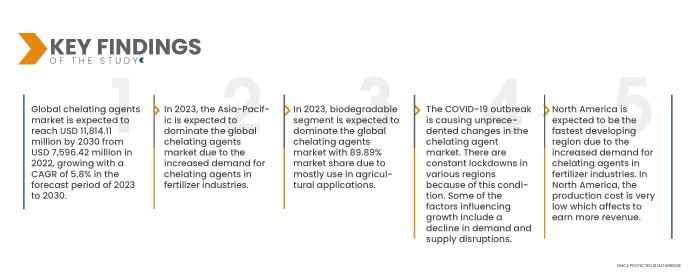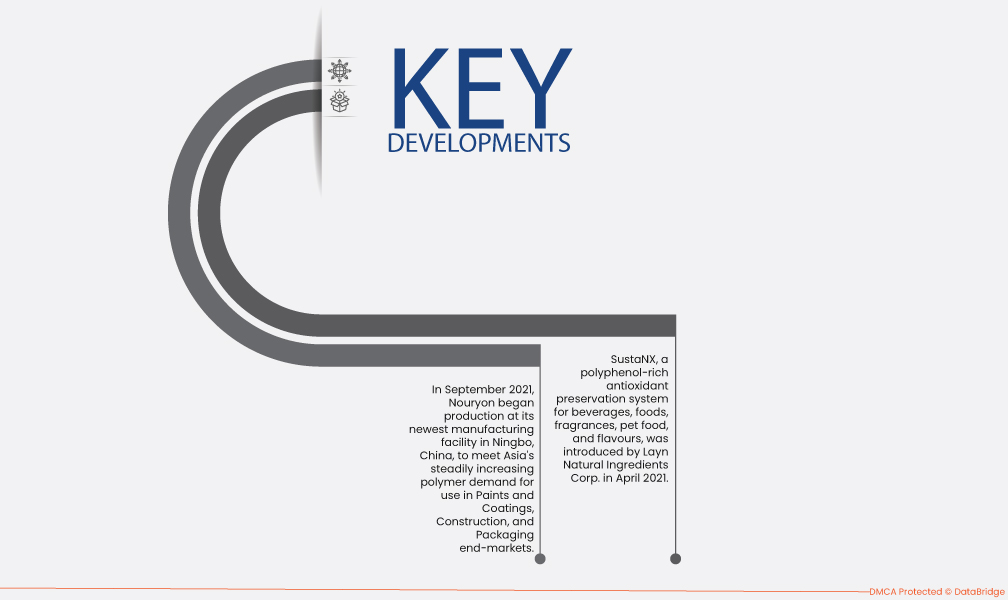Хелатирующие агенты могут изменять естественную видоизменение металлов и их биодоступность и повторно мобилизовать металлы из отложений и водоносных горизонтов, создавая угрозу для грунтовых вод и питьевой воды в высоких концентрациях. Существуют некоторые опасения относительно способности ЭДТА мобилизовать тяжелые металлы из твердых фаз и представлять угрозу для грунтовых вод, а также его плохой биодеградации в естественной среде и на обычных очистных сооружениях. Согласно большинству отчетов, биологическая очистка не позволяет эффективно расщепить хелат.
Доступ к полному отчету по адресу https://www.databridgemarketresearch.com/reports/global-chelating-agent-market
Ожидается, что глобальный рынок хелатирующих агентов достигнет 11 814,11 млн долларов США к 2030 году с 7 596,42 млн долларов США в 2022 году, увеличившись с CAGR на 5,8% в прогнозируемый период с 2023 по 2030 год. Хелатирующие агенты обычно используются в бытовых моющих средствах для предотвращения образования мыльной пены ионами металлов, естественным образом присутствующими в воде. Существует множество хелатирующих агентов, но ЭДТА и лимонная кислота являются двумя наиболее часто встречающимися в чистящих средствах, использующими фосфорные кислоты, которые запрещены в большинстве стран. Чаще всего он используется в чистящих средствах для предотвращения его реакции с минеральными отложениями и образования мыльной пены.
Рост потребления очищенной воды для промышленного использования во всем мире будет способствовать росту рынка.
Микробные флокулянты и использование флокулянтов для роста и жизни содержатся в концепциях флокуляции и биологической среды. Функция и состояние развития микробных флокулянтов, такие как текущая ситуация с микробными флокулянтами, метод флокуляции микробных флокулянтов, синтетические условия и воздействие микробных флокулянтов и активность микробных флокулянтов при обработке сточных вод. Микробные флокулянты разрабатываются с использованием микробных флокулянтов сточных вод. Таким образом, из приведенных выше утверждений можно сделать вывод, что очистные сооружения сточных вод из-за своей восприимчивости к биодеградации и недостаточной впитываемости, что увеличение потребления очищенной воды для промышленного использования, как ожидается, будет способствовать росту мирового рынка хелатирующих агентов в ближайшее время.
Область отчета и сегментация рынка
Отчет Метрика
|
Подробности
|
Прогнозируемый период
|
2023-2030
|
Базовый год
|
2022
|
Исторические годы
|
2021 (Можно настроить на 2015 - 2020)
|
Количественные единицы
|
Доход в млн. долл. США, объемы в единицах, цены в долл. США
|
Охваченные сегменты
|
Тип (аминополикарбоновая кислота (APCA), глюконат натрия , органофосфонат, другие), применение (целлюлозно-бумажная промышленность, бытовая и промышленная уборка, очистка воды, агрохимия, средства личной гигиены, другие)
|
Страны, охваченные
|
США, Канада и Мексика в Северной Америке, Германия, Франция, Великобритания, Нидерланды, Швейцария, Бельгия, Россия, Италия, Испания, Турция, Остальная Европа в Европе, Китай, Япония, Индия, Южная Корея, Сингапур, Малайзия, Австралия, Таиланд, Индонезия, Филиппины, Остальная часть Азиатско-Тихоокеанского региона (APAC) в Азиатско-Тихоокеанском регионе (APAC), Саудовская Аравия, ОАЭ, Южная Африка, Египет, Израиль, Остальной Ближний Восток и Африка (MEA) как часть Ближнего Востока и Африки (MEA), Бразилия, Аргентина и Остальная часть Южной Америки как часть Южной Америки
|
Охваченные участники рынка
|
BASF SE (Германия), Dow (США), Nouryon (Нидерланды), Kemira (Финляндия), Mitsubishi Chemical Holdings Corporation (Япония), Merck KGaA (Германия), Tosoh Corporation (Япония), Hexion (США), Tate & Lyle, (Великобритания), Ascend Performance Materials (США), DuPont (США) Arkema (Франция), LANXESS (США), NIPPON SHOKUBAI CO., LTD. (Япония), Shandong IRO Chelating Chemical Co., Ltd. (Китай), Kemira (Финляндия) и другие
|
Данные, отраженные в отчете
|
Помимо информации о рыночных сценариях, таких как рыночная стоимость, темпы роста, сегментация, географический охват и основные игроки, рыночные отчеты, подготовленные Data Bridge Market Research, также включают в себя углубленный экспертный анализ, географически представленные данные о производстве и мощностях компаний, схемы сетей дистрибьюторов и партнеров, подробный и обновленный анализ ценовых тенденций и анализ дефицита цепочки поставок и спроса.
|
Анализ сегмента:
Мировой рынок хелатирующих агентов подразделяется на четыре основных сегмента: тип, форма, канал сбыта и применение.
- На основе типа рынок сегментируется на синтетические хелатирующие агенты и натуральные хелатирующие агенты. Ожидается, что в 2023 году сегмент синтетических хелатирующих агентов будет доминировать на мировом рынке хелатирующих агентов с долей рынка 87,75% в качестве синтетических хелатирующих агентов в различных отраслях, таких как бытовые рецептуры, включая моющие средства, чистящие средства.
- На основе формы рынок сегментируется на биоразлагаемые и небиоразлагаемые. Ожидается, что в 2023 году биоразлагаемый сегмент будет доминировать на мировом рынке хелатирующих агентов с долей рынка 89,89% из-за использования в основном в сельскохозяйственных целях.
- На основе канала сбыта рынок сегментируется на прямые продажи/B2B, специализированные магазины, склады, электронную коммерцию и др. Ожидается, что в 2023 году сегмент прямых продаж/B2B будет доминировать на мировом рынке хелатирующих агентов с долей рынка 70,44% из-за единственной возможности купить большое количество по низкой цене.
Сегмент прямых продаж/B2B будет доминировать в сегменте каналов дистрибуции на рынке хелатирующих агентов.
Сегмент прямых продаж/B2B станет доминирующим сегментом в канале дистрибуции с долей рынка около 70,00%. Это связано с растущим числом мероприятий по развитию инфраструктуры на рынке, особенно в развивающихся экономиках. Кроме того, рост и расширение химической и материальной промышленности по всему миру еще больше поддержит рост этого сегмента.
- На основе сферы применения рынок сегментирован на целлюлозно-бумажную промышленность, сельское хозяйство, чистящие и моющие средства, промышленную очистку/удаление накипи, горнодобывающую промышленность, текстильную промышленность, нефть и газ, производство полимеров, строительство, фотографию, электротехнику и электронику, пищевые и кормовые добавки, средства личной гигиены, фармацевтику и др. Ожидается, что в 2023 году сегмент целлюлозно-бумажной промышленности будет доминировать на мировом рынке хелатирующих агентов с долей рынка 21,82% благодаря дешевому процессу производства и простоте внедрения в производство.
Целлюлозно-бумажный сегмент будет доминировать в сегменте применения хелатирующих агентов
Сегмент целлюлозы и бумаги станет доминирующим сегментом применения сегмента. Это связано с растущим числом каналов сбыта на рынке, особенно в развивающихся экономиках. Кроме того, рост и расширение услуг по научно-исследовательским разработкам в глобальном масштабе еще больше поддержит рост этого сегмента.
Основные игроки
Data Bridge Market Research признает следующие компании в качестве участников рынка: BASF SE (Германия), Dow (США), Nouryon (Нидерланды), Kemira (Финляндия), Mitsubishi Chemical Holdings Corporation (Япония), Merck KGaA (Германия), Tosoh Corporation (Япония), Hexion (США), Tate & Lyle, (Великобритания), Ascend Performance Materials (США), DuPont (США) Arkema (Франция), LANXESS (США), NIPPON SHOKUBAI CO., LTD. (Япония), Shandong IRO Chelating Chemical Co., Ltd. (Китай), Kemira (Финляндия).
Развитие рынка
- В сентябре 2021 года компания Nouryon начала производство на своем новейшем производственном предприятии в Нинбо, Китай, чтобы удовлетворить постоянно растущий спрос на полимеры в Азии для использования на конечных рынках красок и покрытий, строительства и упаковки. Подразделение компании в Нинбо включает шесть производственных предприятий, которые производят хелатирующие агенты, а также этиленамины, органические пероксиды, поверхностно-активные вещества и эфиры целлюлозы.
- SustaNX — богатая полифенолами антиоксидантная система консервации для напитков, продуктов питания, отдушек, кормов для домашних животных и ароматизаторов — была представлена компанией Layn Natural Ingredients Corp. в апреле 2021 года. Эти передовые формулы консервации состоят из запатентованных и проверенных стандартизированных экстрактов, что обеспечивает простоту приготовления и мягкий сенсорный профиль без заметного влияния на цвет или вкус продукта.
Региональный анализ
Географически в отчете о рынке рассматриваются следующие страны: США, Канада и Мексика в Северной Америке, Германия, Франция, Великобритания, Нидерланды, Швейцария, Бельгия, Россия, Италия, Испания, Турция, остальные страны Европы в Европе, Китай, Япония, Индия, Южная Корея, Сингапур, Малайзия, Австралия, Таиланд, Индонезия, Филиппины, остальные страны Азиатско-Тихоокеанского региона (APAC) в Азиатско-Тихоокеанском регионе (APAC), Саудовская Аравия, ОАЭ, Южная Африка, Египет, Израиль, остальные страны Ближнего Востока и Африки (MEA) как часть Ближнего Востока и Африки (MEA), Бразилия, Аргентина и остальные страны Южной Америки как часть Южной Америки.
Согласно анализу Data Bridge Market Research:
Азиатско-Тихоокеанский регион будет доминирующим регионом на рынке хелатирующих агентов в прогнозируемый период с 2023 по 2030 год.
- Ожидается, что в 2023 году Азиатско-Тихоокеанский регион будет доминировать на мировом рынке хелатирующих агентов из-за возросшего спроса на хелатирующие агенты в индустрии удобрений. В Азиатско-Тихоокеанском регионе ожидается, что Китай будет доминировать на рынке хелатирующих агентов из-за растущего числа случаев отравления в этом регионе.
По оценкам, Северная Америка станет самым быстрорастущим регионом на рынке хелатирующих агентов в прогнозируемый период с 2023 по 2030 год.
Ожидается, что Северная Америка станет самым быстроразвивающимся регионом из-за возросшего спроса на хелатирующие агенты в индустрии удобрений. В Северной Америке себестоимость производства очень низкая, что влияет на получение большего дохода.
Влияние COVID -19
Вспышка COVID-19 вызывает беспрецедентные изменения на рынке хелатирующих агентов. Из-за этого состояния в различных регионах постоянно вводятся локдауны. Некоторые из факторов, влияющих на рост, включают снижение спроса и перебои с поставками. Другим фактором, влияющим на спрос пользователей, является закрытие производственных предприятий. Рынок хелатирующих агентов испытывает тенденции к снижению. Эти факторы оказывают значительное влияние на рынок целлюлозы и бумаги. С закрытием колледжей и университетов индустрия печатной бумаги переживает спад. Доступность средств гигиены, медицинских изделий и специальных видов бумаги снижается. Технологии производства бумаги и целлюлозы подвергаются влиянию с целью снижения рисков, связанных с пандемиями.
Для получения более подробной информации об отчете о рынке хелатирующих агентов нажмите здесь – https://www.databridgemarketresearch.com/reports/global-chelating-agent-market












